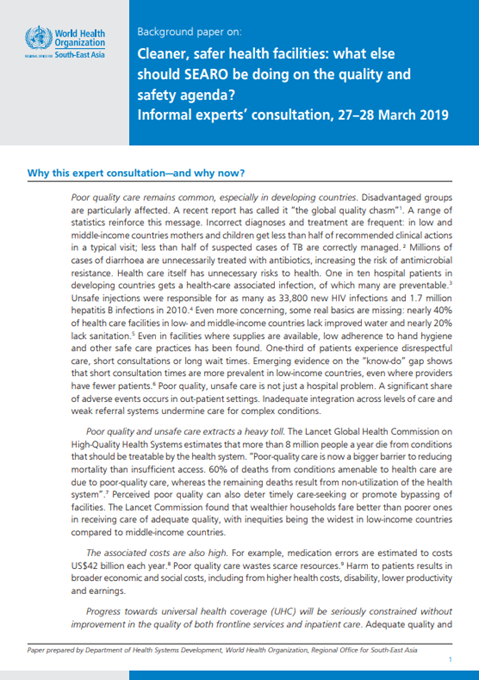Cleaner, safer health facilities: what else should SEARO be doing on the quality and safety agenda?
Background paper: Informal experts’ consultation, 27–28 March 2019

Overview
Poor quality care remains common, especially in developing countries. Disadvantaged groups are particularly affected. A recent report has called it “the global quality chasm.” A range of statistics reinforces this message. Incorrect diagnoses and treatment are frequent: in low- and middle-income countries, mothers and children get less than half of recommended clinical actions in a typical visit; less than half of suspected cases of TB are correctly managed. Millions of cases of diarrhoea are unnecessarily treated with antibiotics, increasing the risk of antimicrobial resistance.
Health care itself has unnecessary risks to health. One in ten hospital patients in developing countries gets a health-care-associated infection, many of which are preventable. Unsafe injections were responsible for as many as 33,800 new HIV infections and 1.7 million hepatitis B infections in 2010.
Even more concerning, some real basics are missing: nearly 40% of health care facilities in low- and middle-income countries lack improved water, and nearly 20% lack sanitation. Even in facilities where supplies are available, low adherence to hand hygiene and other safe care practices has been found. One-third of patients experience disrespectful care, short consultations, or long wait times.
Emerging evidence on the “know-do” gap shows that short consultation times are more prevalent in low-income countries, even where providers have fewer patients. Poor quality, unsafe care is not just a hospital problem. A significant share of adverse events occurs in outpatient settings. Inadequate integration across levels of care and weak referral systems undermine care for complex conditions.
